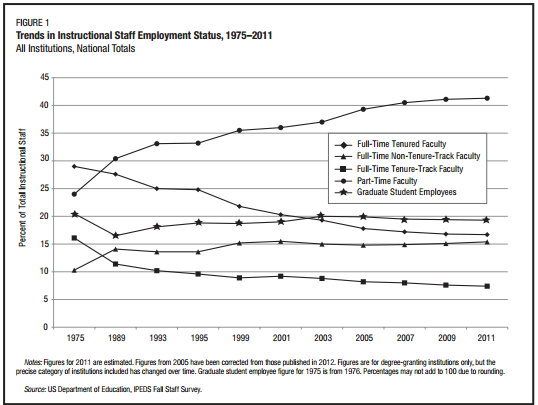Miya Tokumitsu has a solid piece in Jacobin about the issues with the “Do What You Love” work advice. She makes a mistake at one point thought:
The reward for answering this higher calling is an academic employment marketplace in which 76 percent of American faculty are adjunct professors — contract instructors who usually receive low pay, no benefits, no office, no job security, and no long-term stake in the schools where they work.
The mistake is not Tokumitsu’s fault. She got it from Sarah Kendzior who pulls it out often:
On April 8, 2013, the New York Times reported that 76 percent of American university faculty are adjunct professors – an all-time high. Unlike tenured faculty, whose annual salaries can top $160,000, adjunct professors make an average of $2,700 per course and receive no health care or other benefits.
I would be inclined to say that this also is not Kendzior’s fault because she got it from the New York Times. But in fact, the article she got it from does not say that:
And with stretched budgets and public pressure to keep costs down, many colleges and universities are cutting back on tenure and tenure-track jobs. According to the report, such positions now make up only 24 percent of the academic work force, with the bulk of the teaching load shifted to adjuncts, part-timers, graduate students and full-time professors not on the tenure track.
The article says tenured or tenure-track professors make up 24 percent of the workforce. The remainder are not all adjuncts. They are a mix of adjuncts and all these other kinds of employees who the Times distinguishes from adjuncts.
Although the Times does not link to where it got the numbers, it describes their source well enough that you can find it with a search. It is an American Association of University Professors report from 2013. Here is the actual breakdown:

As the AAUP notes, “adjuncts” generally refers to part-time faculty, which are around 41 percent of the work force, not 76 percent. That is a huge difference.
I am not sure if there is some semantic move going on to include all of these other groups under the heading of adjunct. If there is, that should probably be spelled out because, as AAUP notes, the common usage of it generally just refers to those in that part-time line, not to full-time professors who are not tenure track and graduate students.
If you are going to call all of them adjuncts though, you can’t say what Tokumitsu and Kendzior are saying about them as a class of people for the obvious reason that full-time professors are not making what adjuncts make. The AAUP report says they make $47,500 per academic year at the median. I also assume most have offices and benefits, but that I cannot confirm.
Quite a bit of the stuff written about adjuncts is misleading or overblown, judging from the data AAUP puts out about them at least. The last representative survey has the super-majority of them saying they want to work part time. Focuses on their institutional income are misleading precisely because they are part-time and many have other jobs that are primary. Looking at their complete personal income paints a much rosier picture and then looking at their household income paints an even rosier one. Even more recent non-representative surveys put their median household incomes in the $65,000-$75,000 range.
I almost wrote something about this particular 76 percent statistic a while ago when I first spotted it. It comes up a lot in Kendzior’s writing. It’s such a marginal issue that I decided against expending the time. But insofar as it is now influencing other people to make incorrect claims, I figure I might as well go ahead.